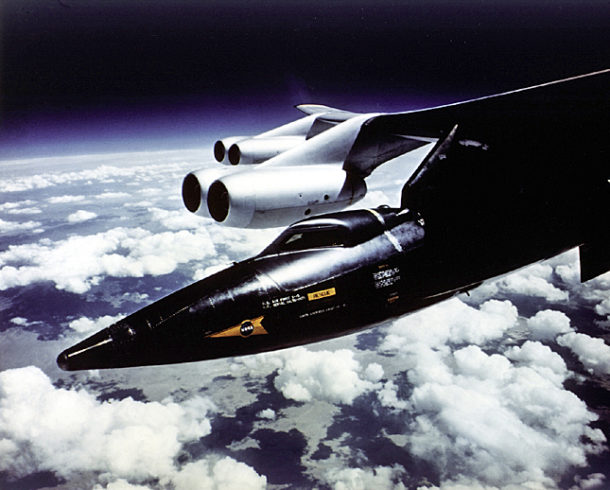
Forty-nine years ago today, USAF Major William F. “Pete” Knight made an emergency landing in X-15 No. 1 at Mud Lake, Nevada. Knight somehow managed to save the hypersonic aircraft following a complete loss of electrical power as the vehicle passed through 107,000 feet during the climb.
The famed X-15 Program conducted 199 flights between June 1959 and October 1968. North American Aviation (NAA) built three (3) X-15 aircraft. Twelve (12) men from NAA, USAF and NASA flew the X-15. Eight (8) pilots received astronaut wings for flying the X-15 beyond 250,000 feet. One (1) aircraft and one (1) pilot were lost during flight test.
The X-15 flew as fast as 4,520 mph (Mach 6.7) and as high as 354,200 feet. The basic airframe measured 50 feet in length, featured a wing span of 22 feet and had a gross weight of 33,000 pounds. The type’s Reaction Motors XLR-99 rocket engine burned anhydrous ammonia and liquid oxygen to produce a sea level thrust of 57,000 pounds. The X-15 used both 3-axis aerodynamic and ballistic flight controls.
An X-15 mission was fast-paced. Flight time from B-52 drop to unpowered landing was typically 10 to 12 minutes in duration. The pilot wore a full pressure suit and experienced 6 to 7 G’s during pull-out from max altitude. There really was no such thing as a routine X-15 mission. However, all X-15 missions had one factor in common; high danger.
On Thursday, 29 June 1967, X-15 No. 1 (S/N 56-6670) made its 73rd and the X-15 Program’s 184th free flight. Launch took place at 1828 UTC as the NASA B-52B launch aircraft (S/N 52-0008) flew at Mach 0.82 and 40,000 feet near Smith Ranch, Nevada. Knight, making his 10th X-15 flight, quickly ignited the XLR-99 and started the climb upstairs.
The X-15 was performing well and Knight was enjoying the flight until 67.6 seconds into a planned 87 second XLR-99 burn. That’s when the engine suddenly quit. A couple of heartbeats later, the Stability Augmentation System (SAS) failed, the Auxiliary Power Units (APU’s) ceased operating, the X-15’s generators stopped functioning and the cockpit lights went out. This was the total hit; a complete power failure.
Pete Knight was now just along for the ride. No thrust to power the aircraft. No electrical power to run onboard systems. No hydraulics to move flight controls. Even the reaction controls appeared inoperative. The X-15 continued upward, but it wallowed aimlessly in the low dynamic pressure of high altitude flight. At this point, Knight considered taking his chances and punching-out.
The X-15 went over the top at 173,000 feet. On the way downhill, Knight was able to get some electrical power from the emergency battery. This meant that he now had some hydraulic power and could utilize the X-15’s flight control surfaces. Knight next tried to fire-up the APU’s. The right APU would not respond. The left APU fired, but the its generator would not engage.
As the X-15 descended and the dynamic pressure built-up, Knight was able to maneuver his stricken X-15. He headed for Mud Lake in a sustained 6-G turn. As he leveled off at 45,000 feet, Knight instinctively knew he could now make the east shore of the Nevada dry lake. But it was tough work to fly the X-15. Knight ended-up using both hands to fly the airplane; one hand on the side stick and one hand on the center stick.
While Knight was trying to get his airplane down on the ground in one piece, only he and his Maker knew his whereabouts. The X-15 flight test team certainly didn’t, since Knight’s radio, telemetry and radar transponder were now inop. Further, the X-15 was not being skinned tracked at the time of the electrical anomaly. Just before he touched-down at Mud Lake, Knight’s X-15 was spotted by NASA’s Bill Dana who was flying a F-104N chase aircraft.
Pete Knight made a good landing at Mud Lake. The X-15 slid to a stop. After a struggle with the release mechanism, he managed to get the canopy open. Hot and soaked with perspiration, Knight somehow removed his own helmet. A ground crewman usually did that for him. But there were no flight support people at his X-15 landing site on this day.
As he attempted to get out of the X-15 cockpit, Knight pulled an emergency release. To his surprise, the headrest blew off, bounced off the canopy and smacked him square in the head. Undeterred, Knight got out of the cockpit and onto terra firma. In the meantime, a Lockheed C-130 Hercules had landed at Mud Lake. Wearily, Pete Knight got onboard and returned to Edwards Air Force Base.
Post-flight investigation revealed that the most probable source of the X-15’s electrical failure was arcing in a flight experiment system. This system had been connected to the X-15’s primary electrical bus. The solution was to connect flight experiments to the secondary electrical bus.
Reflecting on Knight’s amazing recovery from almost certain disaster, long-time NASA flight test manager Paul Bickle claimed the fete was among the most impressive of the X-15 Program. Indeed, it was Pete Knight’s clearly uncommon piloting skill and calmness under pressure that gave him the edge.
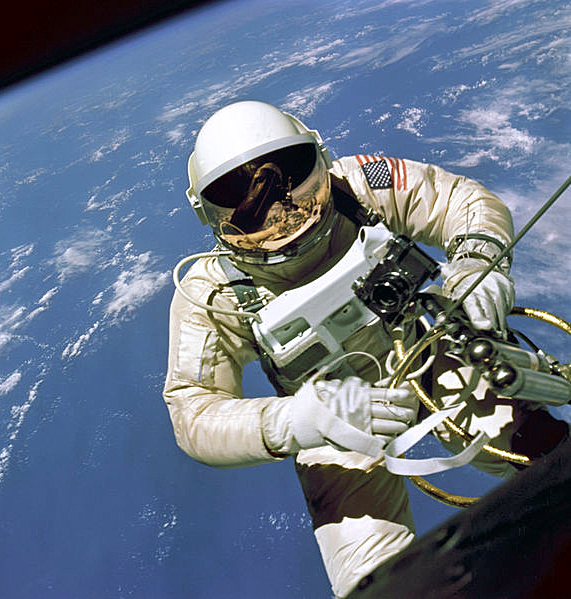
Fifty-one years ago this month, Astronaut Edward H. White II became the first American to perform what in NASA parlance is referred to as an Extra Vehicular Activity (EVA). In everyday terms; a space walk.
White, Mission Commander James A. McDivitt and their Gemini IV spacecraft were launched into low Earth orbit by a two-stage Titan II launch vehicle from LC-19 at Cape Canaveral Air Force Station, Florida. The mission clock started at 15:15:59 UTC on Thursday, 03 June 1965.
On the third orbit, less than five hours after launch, White opened the Gemini IV starboard hatch. He stood in his seat and mounted a camera to capture his historic space stroll. He then cast-off from Gemini IV and became a human satellite.
White was tethered to Gemini IV via a 15-foot umbilical that provided oxygen and communications to his EVA suit. A gold-plated visor on his helmet protected his eyes from the searing glare of the sun. The space-walking astronaut was also outfitted with a hand-held maneuvering unit that used compressed oxygen to power its small thrusters. And, like any good tourist, he also took along a camera.
Ed White had the time of his all-too-brief life in the 22 minutes that he walked in space. The sight of the earth, the spacecraft, the sun, the vastness of space, the freedom of movement all combined to make him exclaim at one point, “I feel like a million dollars!”.
Presently, it was time to get back into the spacecraft. But, couldn’t he just stay outside a little longer? NASA Mission Control and Commander McDivitt were firm. It was time to get back in; now! He grudgingly complied with the request/order, plaintively saying: “It’s the saddest moment of my life!”
As Ed White got back into his seat, he and McDivitt struggled to lock the starboard hatch. Both men were exhausted, but ebullient as they mused about the successful completion of America’s first space walk.
Gemini IV would eventually orbit the Earth 62 times before splashing-down in the Atlantic Ocean at 17:12:11 GMT on Sunday, 07 June 1965. The 4-day mission was another milestone in America’s quest for the moon.
The mission was over and yet Ed White was still a little tired. But then, that was really quite easy to understand. In the time that he was working outside the spacecraft, Gemini IV had traveled almost a third of the way around the Earth.
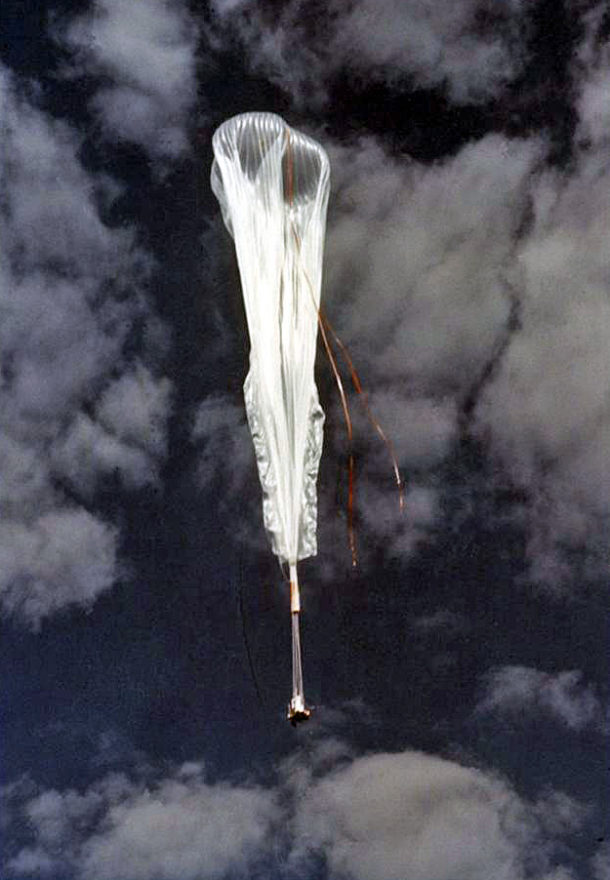
Fifty-nine years ago this month, USAF Captain Joseph W. Kittinger successfully completed the first Manhigh aero medical research balloon mission. During his 6.5-hour flight, Kittinger reached an altitude of 95,200 feet above mean sea level.
Project Manhigh was a United States Air Force biomedical research program that investigated the human factors of spaceflight by taking men into a near-space environment. Preparations for the trio of Manhigh flights began in 1955. The experience and data gleaned from Manhigh were instrumental to the success of the nation’s early manned spaceflight effort.
The Manhigh target altitude was approximately 100,000 feet above sea level. A helium-filled polyethylene balloon, just 0.0015-inches thick and inflatable to a maximum volume of over 3-million cubic feet, carried the Manhigh gondola into the earth’s stratosphere. At float altitude, this balloon expanded to a diameter of roughly 200 feet.
The Manhigh gondola was a hemispherically-capped cylinder that measured 3-feet in diameter and 8-feet in length. It was attached to the transporting balloon via a 40-foot diameter recovery parachute. Although compact, the gondola was amply provisioned with the necessities of flight including life support, power and communication systems. It also included expendable ballast for use in controlling the altitude of the Manhigh balloon.
The Manhigh test pilot wore a T-1 partial pressure suit during the Manhigh mission. This would protect him in the event that the gondola cabin lost pressure at extreme altitude. The pilot was hooked-up to a variety of sensors which transmitted his biomedical information to the ground throughout the flight. This allowed medicos on the ground to keep a constant tab on the pilot’s physical status.
The flight of Manhigh I took place on Sunday, 02 June 1957 with USAF Captain Joseph W. Kittinger as pilot. The massive balloon carrying Kittinger and his gondola was released at 11:23 UTC from Fleming Field Airport, South Saint Paul, Minnesota. In less than 2 hours, Kittinger’s huge balloon reached its design float altitude of 95,200 feet above sea level.
Radio communication problems complicated the Manhigh I mission. While Kittinger could hear the ground, the ground could not hear him. However, the resourceful pilot managed to work around this issue by communicating with the ground via Morse code.
Though balloon, gondola and pilot were functioning quite well, the Manhigh I mission had to be cut short due to rapid depletion of the gondala’s oxygen supply. Post-flight investigation revealed that this anomaly was caused by accidental crossing of the oxygen supply and vent lines prior to the flight.
Kittinger made a safe and uneventful landing near Indian Creek, Minnesota; located roughly 60 nm southeast of the launch site. The recovery crew was quick to the scene and extracted the plucky pilot from the sealed balloon gondola which had fallen over on its side. The official mission elapsed time (MET) was recorded as 6 hours and 32 minutes.
The flight of Manhigh I was a significant technical accomplishment that materially contributed to the advancement of manned spaceflight. Indeed, a TIME Magazine article, entitled “Prelude to Space” and dated 17 June 1957, captured the essence of the achievement. A man had been subjected to space-equivalent physiological conditions for a protracted period, had functioned well in that environment, and then returned safely to earth without ill effect.
For his significant efforts during the Manhigh I mission, Captain Joseph W. Kittinger received the USAF Distinguished Flying Cross.
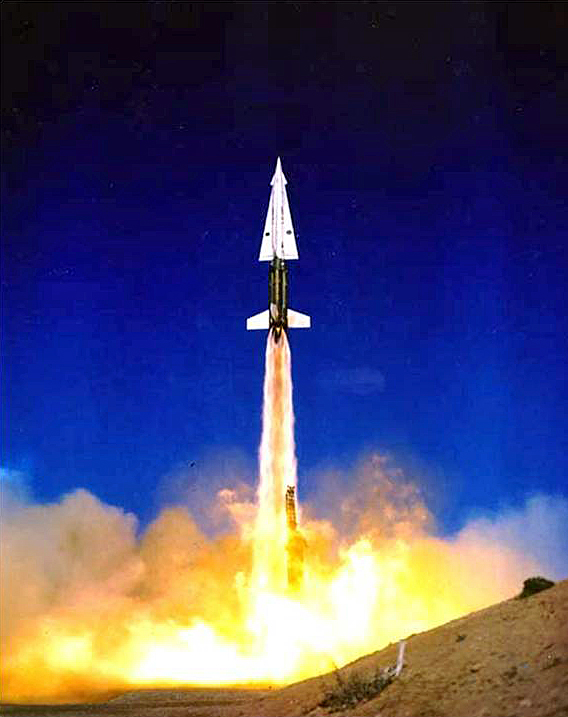
Fifty-eight years ago this month, the United States Army Nike Hercules air defense missile system was first deployed in the continental United States. The second-generation surface-to-air missile was designed to intercept and destroy hostile ballistic missiles.
The Nike Program was a United States Army project to develop a missile capable of defending high priority military assets and population centers from attack by Soviet strategic bombers. Named for the Greek goddess of victory, the Nike Program began in 1945. The industrial consortium of Bell Laboratories, Western Electric, Hercules and Douglas Aircraft developed, tested and fielded Nike for the Army.
Nike Ajax (MIM-3) was the first defensive missile system to attain operational status under the Nike Program. The two-stage, surface-launched interceptor initially entered service at Fort Meade, Maryland in December of 1953. A total of 240 Nike Ajax launch sites were eventually established throughout CONUS. The primary assets protected were metropolitan areas, long-range bomber bases, nuclear plants and ICBM sites.
Nike Ajax consisted of a solid-fueled first stage (59,000 lbs thrust) and a liquid-fueled second stage (2,600 lbs thrust). The launch vehicle measured nearly 34 feet in length and had a ignition weight of 2,460 lbs. The second stage was 21 feet long, had a maximum diameter of 12 inches and weighed 1,150 lbs fully loaded. The type’s maximum speed, altitude and range were 1,679 mph, 70,000 feet and 21.6 nautical miles, respectively.
The Nike Hercules (MIM-14) was the successor to the Nike Ajax. It featured all-solid propulsion and much higher thrust levels. The first stage was rated at 220,000 lbs of thrust while that of the second stage was 10,000 lbs. The Nike Hercules airframe was significantly larger than its predecessor. The launch vehicle measured 41 feet in length and weighed 10,700 lbs at ignition. Second stage length and ignition weight were 26.8 feet and 5,520 lbs, respectively.
Nike Hercules kinematic performance was quite impressive. The respective top speed, altitude and range were 3,000 mph, 150,000 feet and 76 nautical miles. This level of performance allowed the vehicle to be used for the ballistic missile intercept mission. Most Nike Hercules missiles carried a nuclear warhead with a yield of 20 kilotons.
The first operational Nike Hercules systems were deployed to the Chicago, Philadelphia and New York localities on Monday, 30 June 1958. By 1963, fully 134 Nike Hercules batteries were deployed throughout CONUS. These systems remained in the United States missile arsenal until 1974. The exceptions were batteries located in Alaska and Florida which remained in active service until the 1978-79 time period.
Like Nike Ajax before it, Nike Hercules had a successor. It was originally known as Nike Zeus and then Nike-X. This Nike variant was designed for intercepting enemy ICBM’s that were targeted for American soil. The vehicle went through a number of iterations before a final solution was achieved. Known as Spartan, this missile was what we would refer to today as a mid-course interceptor.
In companionship with a SPRINT terminal phase interceptor, Spartan formed the Safeguard Anti-Ballistic Missile System. The American missile defense system was impressive enough to the Soviet Union that the communist country signed the Anti-Ballistic Missile (ABM) Treaty 3 years before Safeguard’s deployment. Though operational for a mere 3 months, Safeguard was depostured in 1975. This action brought to a close a 30-year period in which the Nike Program was a major player in American missile defense.
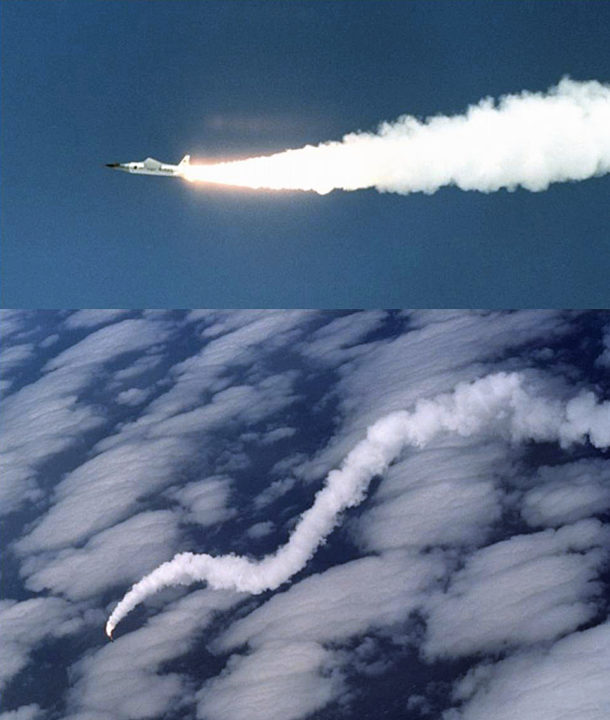
Fifteen years ago today, the first NASA X-43A airframe-integrated scramjet flight research vehicle was launched from a B-52 carrier aircraft high over the Pacific Ocean. The inaugural mission of the HYPER-X Flight Project came to an abrupt end when the launch vehicle departed controlled flight while passing through Mach 1.
In 1996, NASA initiated a technology demonstration program known as HYPER-X (HX). The central goal of the HYPER-X Program was to successfully demonstrate sustained supersonic combustion and thrust production of a flight-scale scramjet propulsion system at speeds up to Mach 10.
Also known as the HYPER-X Research Vehicle (HXRV), the X-43A aircraft was a scramjet test bed. The aircraft measured 12 feet in length, 5 feet in width, and weighed close to 3,000 pounds. The X-43A was boosted to scramjet take-over speeds with a modified Orbital Sciences Pegasus rocket booster.
The combined HXRV-Pegasus stack was referred to as the HYPER-X Launch Vehicle (HXLV). Measuring approximately 50 feet in length, the HXLV weighed slightly more than 41,000 pounds. The HXLV was air-launched from a B-52 mothership. Together, the entire assemblage constituted a 3-stage vehicle.
The first flight of the HYPER-X program took place on Saturday, 02 June 2001. The flight originated from Edwards Air Force Base, California. Using Runway 04, NASA’s venerable B-52B (S/N 52-0008) started its take-off roll at approximately 19:28 UTC. The aircraft then headed for the Pacific Ocean launch point located just west of San Nicholas Island.
At 20:43 UTC, the HXLV fell away from the B-52B mothership at 24,000 feet. Following a 5.2 second free fall, the rocket motor lit and the HXLV started to head upstairs. Disaster struck just as the vehicle accelerated through Mach 1. That’s when the rudder locked-up. The launch vehicle then pitched, yawed and rolled wildly as it departed controlled flight. Control surfaces were shed and the wing was ripped away. The HXRV was torn from the booster and tumbled away in a lifeless state. All airframe debris fell into the cold Pacific Ocean far below.
The mishap investigation board concluded that no single factor caused the loss of HX Flight No. 1. Failure occurred because the vehicle’s flight control system design was deficient in a number of simulation modeling areas. The result was that system operating margins were overestimated. Modeling inaccuracies were identified primarily in the areas of fin system actuation, vehicle aerodynamics, mass properties and parameter uncertainties. The flight mishap could only be reproduced when all of the modeling inaccuracies with uncertainty variations were incorporated in the analysis.
The X-43A Return-to-Flight effort took almost 3 years. Happily, the HYPER-X Program hit paydirt twice in 2004. On Saturday, 27 March 2004, HX Flight No. 2 achieved scramjet operation at Mach 6.83 (almost 5,000 mph). This historic accomplishment was eclipsed by even greater success on Tuesday, 16 November 2004. Indeed, HX Flight No. 3 achieved sustained scramjet operation at Mach 9.68 (nearly 7,000 mph).
The historic achievements of the HYPER-X Program went largely unnoticed by the aerospace industry and the general public. For its part, NASA did not do a very good job of helping people understand the immensity of what was accomplished. Even the NASA Administrator appeared indifferent to the scramjet program. While he attended an X-Prize flight by Scaled-Composites’ SpaceShipOne right up the street at the Mojave Spaceport, he did not see fit to attend either of that year’s historic scramjet flights that originated right down the road at Edwards Air Force base.
However, it was the loss of the Space Shuttle Columbia on STS-107 in February of 2003 that doomed HX even before the program’s first successful flight. Everything changed for NASA when Columbia and its crew was lost. The space agency’s overriding focus and meager financial resources went into the Shuttle Return-to-Flight and Phase-Out efforts. NASA’s aeronautical and access-to-space arms were especially hard hit.
If timing is everything as some insist, then the HYPER-X Program was really the victim of bad timing. It is both intriguing and distressing to ponder what would have been the case if HX Flight No. 1 had been successful. The likely answer is that at least one of the anticipated follow-on scramjet flight research programs (i.e., X-43B, X-43C, and X-43D) would have been developed and flown. Thanks to Murphy’s ubiquitous influence, we’ll never know.





